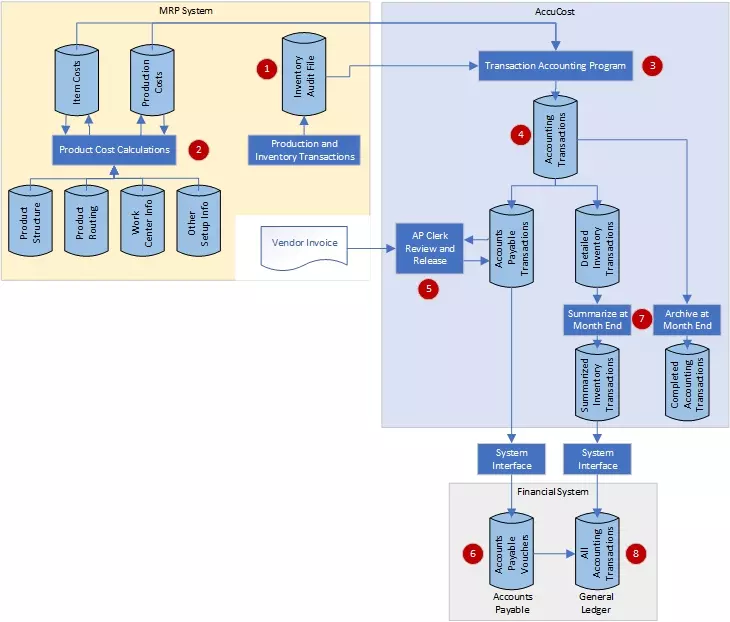For background on this particular project, please visit A Series of Unexpected Benefits.
Situation ...
Our client is a large apparel manufacturer, producing a very large number of small knit products every day. Our client's product line and manufacturing operations had recently gone through numerous changes, and systems and accounting personnel were doing their best to handle the changes.
Opportunity ...
Two physical inventories, conducted within 6 months of each other, each resulted in a physical inventory shrink of over $1 million. A new CFO was brought in to address the problem, and worked with his staff to find likely causes of the shrinks. The suspected culprit – inaccurate production accounting entries, resulting from system reports that had not been updated to reflect the changed product line and manufacturing operations, and calculation errors made in various spreadsheets.
Solution ...
Our client's idea was to automate the production accounting as much as possible to eliminate major sources of error, and thus accurately cost inventory at all stages of completion – hence, the system name, AccuCost.
We researched the information available in their Materials Requirement Planning (MRP) system, and found an Inventory Audit File that logged every production, inventory movement, and inventory adjustment transaction. Thus, our client's idea was feasible.
We outlined the accounting entries required to accurately cost inventory transactions, determined the MRP system's sources of information required to do the production accounting, and converted all this into system design documents the client's systems analyst and programmers could use to develop the new system. We then worked closely with client personnel to ensure questions were quickly answered and modules were thoroughly tested as soon as they were ready.
The main AccuCost processing runs every night, scanning the Inventory Audit File for unprocessed transactions, determining the appropriate accounting treatment for each transaction, creating the accounting transactions, and marking the Inventory Audit File transaction as processed. The accounting transactions fell into one of two categories:
- Accounts Payable (AP) – When inventory is received against a Purchase Order, AccuCost creates an AP Voucher, marks it as "Awaiting Invoice," and sends the voucher to the AP system.
- Inventory – All other transactions, such as production and inventory movement, result in AccuCost creating a Journal Entry (JE) detailing the accounting treatment.

- The MRP system has robust capabilities to capture all inventory-related transactions, all stored the "Inventory Audit File."
- The MRP system has sophisticated features to handle various production configurations, and accurately calculate and store the costs added at each production stage and the item's completed cost.
- The main AccuCost processing runs every night, selecting unprocessed inventory transactions, creating accounting transactions, and marking the inventory transaction as processed.
- There are two types of accounting transactions:
- Accounts Payable (AP) – AccuCost creates an AP Voucher, and sends it to the AP system.
- Inventory – These result in an AccuCost Journal Entry (JE) detailing the accounting treatment.
- When a vendor's invoice arrives, the AP clerk finds the associated AP Voucher in AccuCost and compares the invoice and voucher amounts.
- If they are the same, the AP clerk removes the "Awaiting Invoice" flag.
- If they differ, the AP clerk investigates the difference and creates an adjustment, if needed – once the difference is resolved, the AP clerk removes the "Awaiting Invoice" flag.
- The AP system receives information from AccuCost for both the creation of the AP Voucher and the approval to release it for payment. For both events, the AP System sends transactions to the General Ledger (GL).
- At month-end, AccuCost summarizes the Inventory Accounting JE's and passes them to the GL, then archives all completed accounting transactions.
- The GL now reflects all the accounting transactions created from every inventory-related transaction recorded in the MRP System during the month.
Results and Benefits ...
Six months after AccuCost was launched, another physical inventory was taken – and the inventory shrink was less than $20,000.
Not only was inventory now being accounted for accurately, our client finally had detailed cost data for every transaction, which allowed them to better analyze cost variances, and more easily pinpoint quality problems – and begin to quickly address both cost and quality issues.
Furthermore, AccuCost produced benefits above and beyond eliminating physical inventory shrink and providing detailed data for analysis, including slashing the month-end closing process and improving net income.
Conclusion ...
With a pragmatic division of responsibilities between client staff and our personnel, our client was able to cost-effectively leverage our specialized skills and knowledge, and their system development capabilities, for this transformational project.





